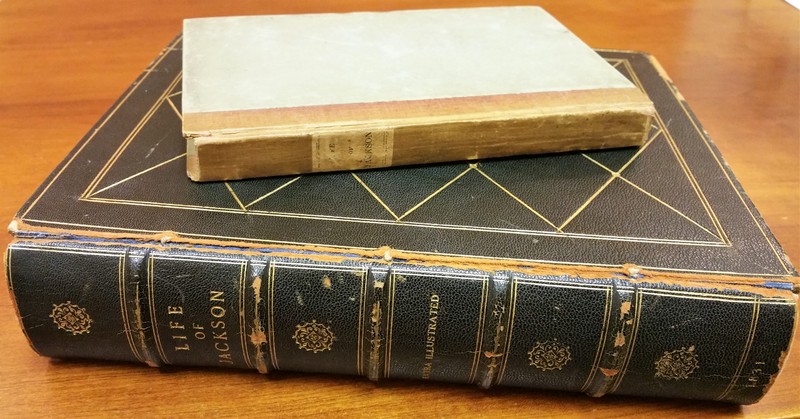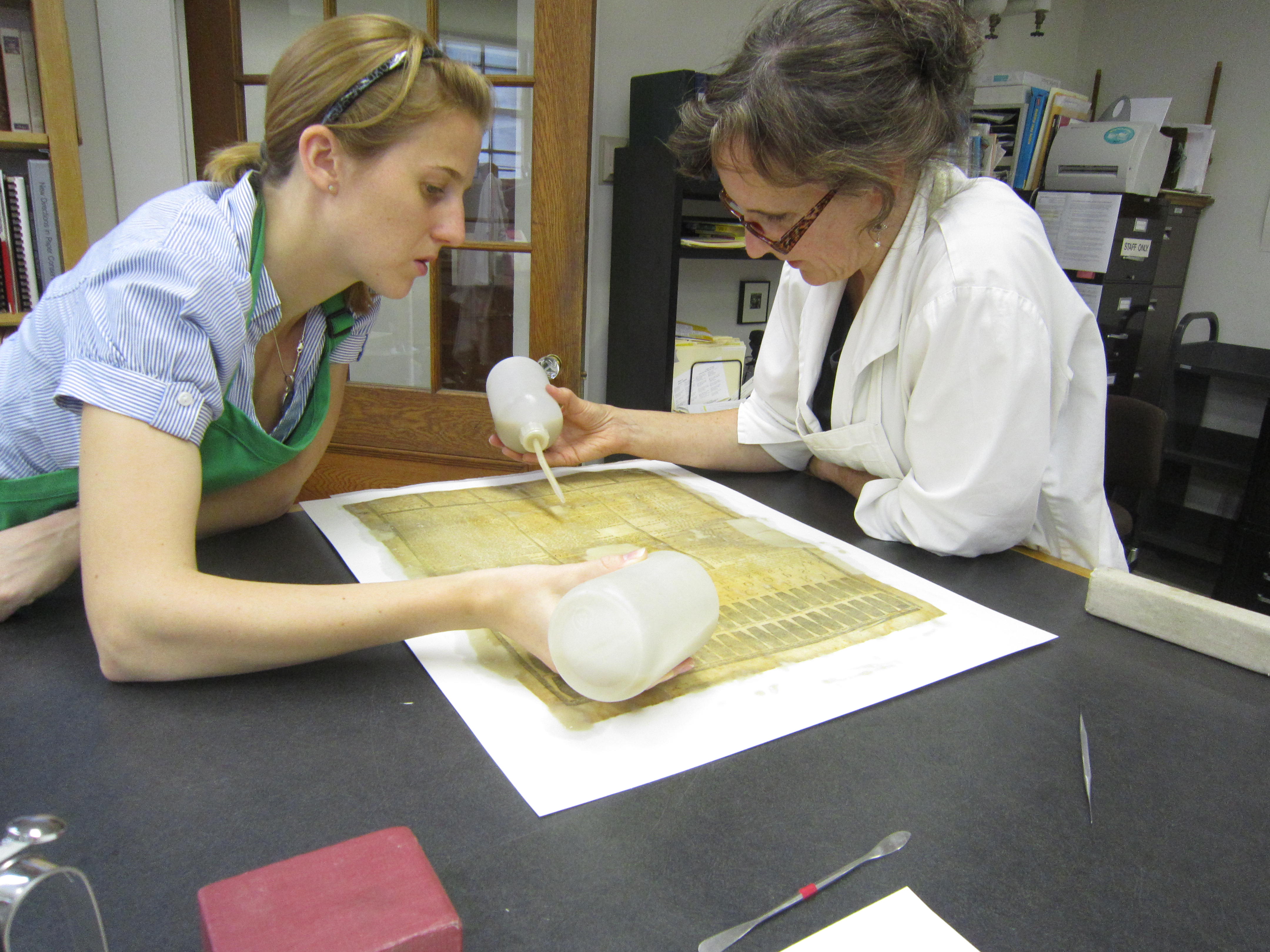Conserve & Preserve

Click here to learn more about the extra-illustrated Life of Jackson, which will be housed in a custom phase-box to protect the binding, with tissue interleaved between pages with color illustrations.
A book's physical well-being is of paramount importance at this point in the life cycle of a book becoming part of a library collection.
Is its binding busted? Does it have red rot (i.e., deteriorating vegetable-tanned leather)? Is there active mold? Without the dedicated staff in the AAS Conservation Department, many books would be inaccessible to researchers because any manipulation of them would be detrimental to the health of either the researcher or the book. The goal of conservation is to keep an item physically safe and stable, while allowing it to be used.
Conservation vs. Preservation
The terms “conservation” and “preservation” are often used interchangeably, though that is technically incorrect. Conservation involves active management and intervention to fix something; preservation is the more passive prevention of change from the original state. In the rare book world, conservation treatments are active interventions to improve the physical condition of a unique item or collection using techniques such as paper repair or mold remediation. Preservation projects are aimed at preventing future damage or loss by monitoring and modifying the environment, such as assessing the housing, shelving, and storage of collections or maintaining an up-to-date disaster plan. The Conservation Department at AAS also does the work of preservation, since the two often go hand in hand—once you have conserved a book, it makes sense to preserve it from future damage.
Treatments
Most of the books in the William C. Cook Jacksonian Era Collection arrived in good condition, but other collections do not always arrive in top physical shape. The American Antiquarian Society generally does not accept books with mold or insect issues, but there is a deep freezer to treat the few items that come in with such issues. Should items require it, paper treatments and repairs may also be done. A typical paper treatment may involve the following steps, as described by AAS conservation staff:
- Assess — A thorough examination must first be conducted to determine the extent of the damage. Common issues include paper tears, losses, and stains, but the paper may be soiled, creased, stained, mutilated, brittle, yellowed, or foxed. Manuscript additions using iron gall ink can be particularly damaging to paper.
- Document — If a significant treatment is to be done, the conservator starts by thoroughly documenting the object in its current state. A detailed description of its condition is written up and captured visually with digital photography. In cases where the damage is extensive, a representative sampling is shot both before and after treatment. Conservation Treatment Records are kept on file for extensive treatments, and all treatments are noted in the catalog record for the item.
- Take apart — Books or pamphlets may have to be may be disbound and the pages cleaned of surface grime before washing.
- Bathe — Sometimes the paper is suffering from earlier tape “repairs.” The type of adhesive must first be determined; hopefully it is glassine tape with a water-soluble adhesive that will be easily removed in a water bath. After any tape floats off and the acids are removed from the paper, it would be alkalized (sometimes with a magnesium solution), and when dry, resized (sometimes with gelatin). Sometimes the washing is done on a capillary fleece to reduce discoloration.
- Repair — Now is the time to reattach all the little bits that came apart when the glassine came off. Usually tears are mended and losses filled with Japanese tissue and wheat starch paste. If the damage is extensive, though, the book might be a better candidate for a pulp fill, which tends to be more seamless. AAS conservator Laura Oxley made pulp fills sound like a fun art project when she described the process in a blog post:
Making fills with pulp is fun, and creative, even kind of artsy – one tears into small pieces a variety of high-quality handmade papers (old and new) in an attempt to match the hue and tone for the area you are repairing. These are whirred up in a blender with water (passersby are unable to resist the smoothie joke) until you have a suitably blended paper pulp. It can take a bit of tweaking, but is highly satisfying when you’ve gotten it right. You then fill a squeeze bottle with the pulp and apply it to the wet object on Hollytex (a synthetic material which allows water to flow through, but prevents sticking) and blotters. It is then dried under pressure between felts.
Interested in learning more? On the AAS blog, Past is Present, there are periodically blog posts about conservation topics, including recent treatments and updates on the Society’s new conservation lab.
Housing & Shelving
After any conservation treatments are done, each new acquisition is assessed for its housing needs before reaching its permanent home in the AAS stacks. Housing in this instance refers to supportive enclosures such as envelopes, folders, and boxes. Most nonbook collections, including pamphlets, always require protective housing. Books, however, are often able to travel to the shelves naked as the day they arrived thanks to the sturdy bindings that have already allowed them to survive for hundreds of years. The codex is an amazingly resilient form.
The most fragile books or very early publications have custom phase boxes created especially for them. Only a few items in the William C. Cook Jacksonian Era Collection needed a little extra support, so Gaylord binders were used. These come in standardized sizes that can be slightly modified so that they almost exactly fit each individual book. Each volume then is carefully shelved in the Society’s closed stacks, where it will remain on a shelf in a secure, climate-controlled environment waiting for a researcher to discover it thanks to AAS’s detailed cataloging.


